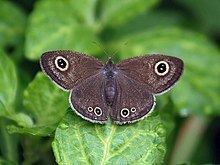Genus Ypthima Rank Species | ||
 | ||
Similar Ypthima, Orsotriaena medus, Ypthima ceylonica, Mycalesis visala, Dingy Bushbrown | ||
Common four ring ypthima huebneri shrikant madhav kelkar
Ypthima huebneri (common fourring) is a species of Satyrinae butterfly found in Asia.
Contents
- Common four ring ypthima huebneri shrikant madhav kelkar
- Wet season form
- Dry season form
- Racial variation
- Distribution
- Life history
- References
Wet-season form
Upperside greyish brown. Forewing with the usual comparatively large, bi-pupilled, yellow-ringed, black pre-apical ocellus. Hindwing usually with two, sometimes with three, very rarely without any, smaller similar uni-pupilled post-discal ocelli. Underside greyish white, not very densely covered with transverse short brown striae. Forewing with the preapical ocellus as on the upperside, obscure discal and subterminal dull brown transverse fasciae and a narrow brown ring round the ocellus diffusely produced posteriorly. Hindwing with one apical and typically three postdiscal posterior ocelli placed in a curve; traces of transverse brown discal and subterminal fasciae in most specimens. Antenna, head, thorax and abdomen greyish brown, the abdomen paler beneath. Male without secondary sex-mark.
Dry-season form
Similar, somewhat paler on both upper and under sides; the discal and subterminal transverse fasciae more pronounced; the ocelli on the underside of the hindwing minute or absent.
Adults have a wingspan of 40-44 mm.
Racial variation
Var. jocularia, Swinhoe, is the pale form from Western India "said by Messrs. Elwes and Edwards to be nearest to kashmira, Moore."(quoted in Bingham)
Race kashmira, Moore, differs from the typical form in the darker and more uniform colour of the upperside, in the ground colour on the underside being dull brownish not white, and the wings non-fasciated in most specimens, or with only the sub-terminal fascia on the forewing. The clasp in the male differs, however, considerably from that of Y. huebneri.
Wingspan of 33-39 mm. Found in N.W. Himalayas; Kashmir; S. India, Mysore and the Anaimalai Hills (fide Elwes quoted in Bingham).
Race ceylonica: Upperside vandyke-brown to dark sepia-brown. Forewing uniform, with the usual single preapical ocellus. Hindwing: posterior half, sometimes less than hall:, pure white, with two or three small posterior ocelli, a lunular incomplete subterminal and an even slender terminal brown line. Underside white.with somewhat sparse, short, delicate, fine transverse brown stride, getting denser towards the apex of the forewing. Tore wing with the ocellus, a brown ring surrounding it very broad and very broadly and diffusely produced downwards, discal and subterminal transverse fascial obscure. Hindwing with four ocelli in a curve, the anal bi-pupilled; traces of a discal transverse brown fascia and of a lunular subterminal brown line. Antennae, head, thorax and abdomen brown; abdomen white beneath. Wingspan of 34-40 mm. Found in Bengal, Orissa; S. India, the Nilgiris, Travancore: Ceylon.
Distribution
Throughout peninsular India, Assam and Burma also Malaysia and Indochina.
Life history
Larva. About one inch in length, with two divergent processes from the anal segment pointing backwards. "Colour entirely green with a dorsal line somewhat darker green, which becomes white at the fourth segment, and extends right through the crown of the head; there is also a paler green lateral line below the spiracles." (de Niceville quoted in Bingham) Host plants include Axonopus compressus.
Pupa. "Green or brown, with the head rounded, the edges of the wing-cases raised and angled anteriorly; the thorax humped and marked like the abdominal segments, with some dark brown waved lines and spots" (de Niceville quoted in Bingham)
